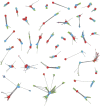Gene similarity networks provide tools for understanding eukaryote origins and evolution
- PMID: 23576716
- PMCID: PMC3637751
- DOI: 10.1073/pnas.1211371110
Gene similarity networks provide tools for understanding eukaryote origins and evolution
Abstract
The complexity and depth of the relationships between the three domains of life challenge the reliability of phylogenetic methods, encouraging the use of alternative analytical tools. We reconstructed a gene similarity network comprising the proteomes of 14 eukaryotes, 104 prokaryotes, 2,389 viruses and 1,044 plasmids. This network contains multiple signatures of the chimerical origin of Eukaryotes as a fusion of an archaebacterium and a eubacterium that could not have been observed using phylogenetic trees. A number of connected components (gene sets with stronger similarities than expected by chance) contain pairs of eukaryotic sequences exhibiting no direct detectable similarity. Instead, many eukaryotic sequences were indirectly connected through a "eukaryote-archaebacterium-eubacterium-eukaryote" similarity path. Furthermore, eukaryotic genes highly connected to prokaryotic genes from one domain tend not to be connected to genes from the other prokaryotic domain. Genes of archaebacterial and eubacterial ancestry tend to perform different functions and to act at different subcellular compartments, but in such an intertwined way that suggests an early rather than late integration of both gene repertoires. The archaebacterial repertoire has a similar size in all eukaryotic genomes whereas the number of eubacterium-derived genes is much more variable, suggesting a higher plasticity of this gene repertoire. Consequently, highly reduced eukaryotic genomes contain more genes of archaebacterial than eubacterial affinity. Connected components with prokaryotic and eukaryotic genes tend to include viral and plasmid genes, compatible with a role of gene mobility in the origin of Eukaryotes. Our analyses highlight the power of network approaches to study deep evolutionary events.
Conflict of interest statement
The authors declare no conflict of interest.
Figures




References
-
- Embley TM, Martin W. Eukaryotic evolution, changes and challenges. Nature. 2006;440(7084):623–630. - PubMed
-
- Martin W. Archaebacteria (Archaea) and the origin of the eukaryotic nucleus. Curr Opin Microbiol. 2005;8(6):630–637. - PubMed
-
- Martin W, et al. The evolution of eukaryotes. Science. 2007;316(5824):542–543, author reply 542–543. - PubMed
Publication types
MeSH terms
Substances
LinkOut - more resources
Full Text Sources
Other Literature Sources
Medical

